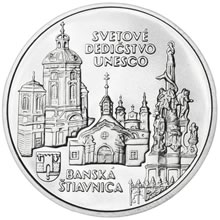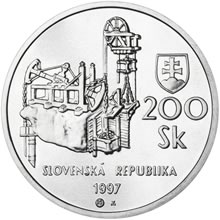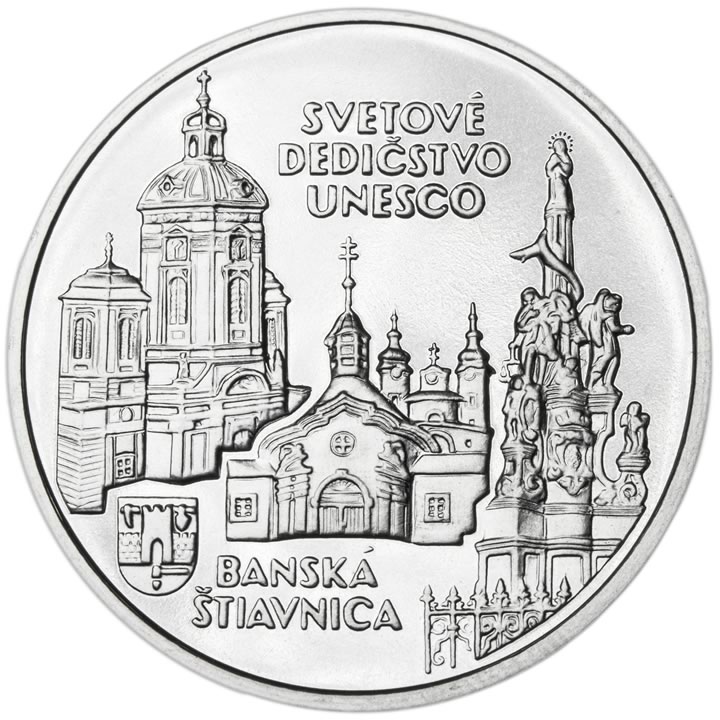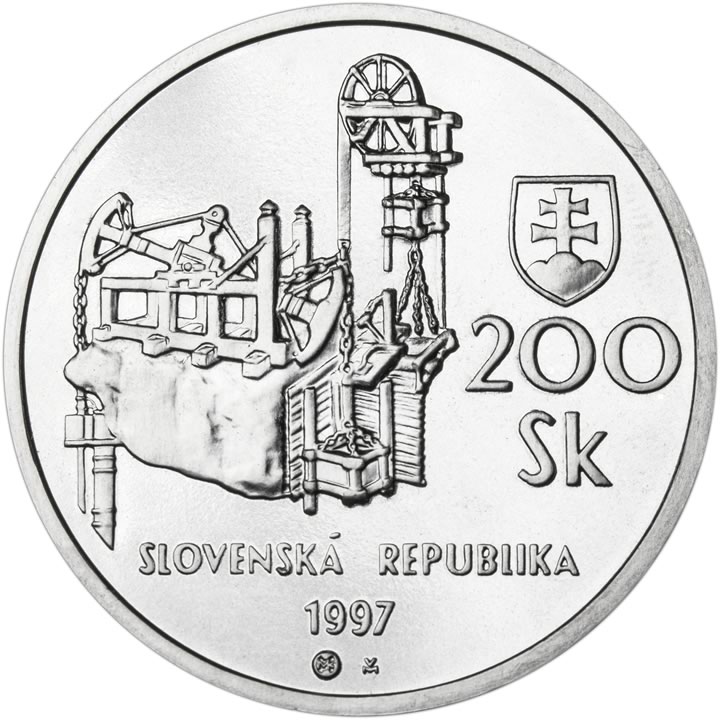Pamětní stříbrná mince v nominální
hodnotě 200 slovenských korun s tématikou Světové dědictví UNESCO
– Banská Štiavnica a technické památky okolí
Banská Štiavnica, nejstarší hornické
město na Slovensku, měla dominantní postavení v Evropě už začátkem
13. století. Na listině vydané už v roku 1275 se zachovala nejstarší
známá městská pečeť v středověkém Uhersku. Od 13. do. 19 století
byla jedním z nejvýznamnějších středisek těžby zlata a stříbra
a současně nejvýznamnějším centrem hornické vědy, techniky a školství.
V městě a jeho okolí byl v 18. století dobudován nejdůmyslnější
hornický vodohospodářský systém na světě s progresivní hornickou,
úpravní a vodočerpací technikou. Světový význam dosáhla zásluhou
Hornické akademie (1762 – 1919), kterou tu založila císařovna Marie
Terezie jako první svého druhu na světe. Pro jedinečné architektonické
památky ji roku 1950 vyhlásili za městskou památkovou rezervaci. Banská
Štiavnica a technické památky v jejím okolí byly v prosinci 1993
zapsané do Seznamu světového dědictví UNESCO.
Commemorative
silver coin with the face value of 200 Slovak crown UNESCO World Heritage –
Banská Štiavnica and its ancient mining works
Banská
Štiavnica, the oldest mining town in Slovakia, had a dominant position in
Europe already at the beginning of the 13th century; a document
form 1275, preserves the earliest known town seal in mediaeval Hungary. From
the 13th to the 19th century. Banská Štiavnica was an
important centre for the mining of gold and silver, and at the same time a
centre of mining science, engineering and education. the most ingenious mining
water management system anywhere in the world, was constructed here in the 18th
century, with advanced equipment for the distribution and pumping of water.
The Mining Academi (1762 – 1919), established here by the Empress Maria
Theresa as the first of its kind in the world, did much to increase the
importance of the town. In 1950 the town was declared a national heritage site
on account of its unique architecture. Banská Štiavnica and its ancient
mining works were added to the UNESCO List of World Heritage, in December
1993.
Silberne
Gedenkmünze im Nominalwert von 200 slowakischen Kronen Welterbschaf UNESCO
– Banská Štiavnica und die technische Denkmäler derer Umgebung
Banská
Štiavnica, die älteste Bergbaustadt der Slowakei, hatte eine dominierende
Stellung im Europa schon anfangs des 13. Jahrhunderts. Mit der im Jahre 1275
herausgegebenen Urkunde hat sich das älteste Stadtsiegel im mittelalterlichen
Ungarn erhalten. Vom 13. bis 19. Jahrhundert war diese Stadt eine der
bekanntesten Zentren der Gewinnung von Gold und Silber sowie der Bergbaukunde,
Bergwerken und Spezialausbildung. In der Stadt und derer Umgebung wurde im 18.
Jahrhundert damals das klügste Wasserwirtschaftssystem der Welt, mit
progressiven Bergbautechnik, Wasseraufbereitungsanlagen und Schopfwerken,
vollendet. Die Stadt erlang Weltgeltung dank der Bergakademie, die die
Kaiserin Maria Theresa errichtete, als erste Anstalt dieser Art in der Welt
(1762 – 1919). Wegen der architektonischen Denkmäler wurde diese Stadt im
Jahre 1950 zur städtischen Denkmalreservation erklärt. Die Stadt Banská Štiavnica
und die technischen Denkmäler derer Umgebung wurde im Dezember 1993 in die
Welterbschaftsliste der UNESCO aufgenommen.



